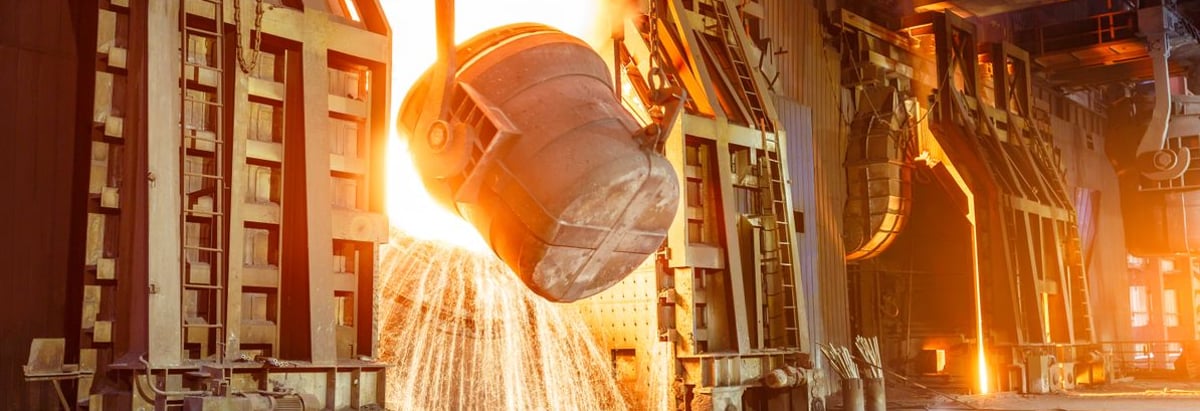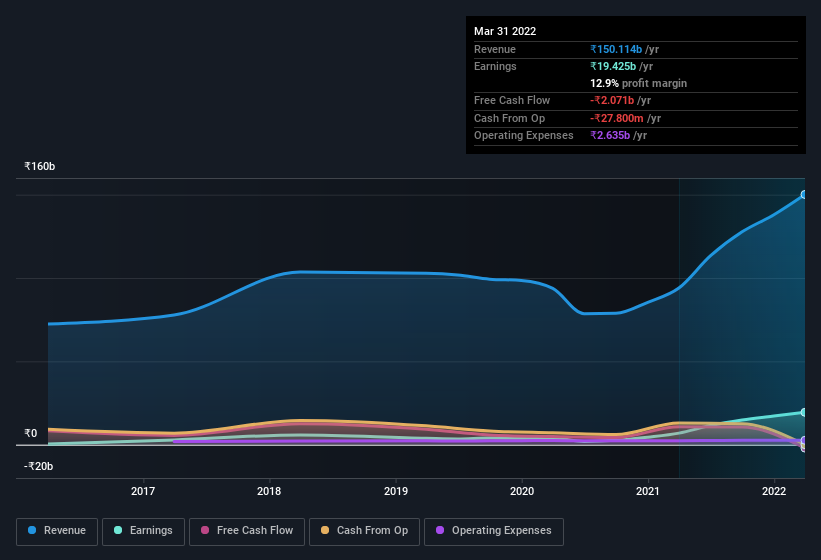- India
- /
- Metals and Mining
- /
- NSEI:JSLHISAR
Jindal Stainless (Hisar)'s (NSE:JSLHISAR) Earnings Are Of Questionable Quality

Despite posting some strong earnings, the market for Jindal Stainless (Hisar) Limited's (NSE:JSLHISAR) stock hasn't moved much. Our analysis suggests that this might be because shareholders have noticed some concerning underlying factors.
Check out our latest analysis for Jindal Stainless (Hisar)

A Closer Look At Jindal Stainless (Hisar)'s Earnings
One key financial ratio used to measure how well a company converts its profit to free cash flow (FCF) is the accrual ratio. The accrual ratio subtracts the FCF from the profit for a given period, and divides the result by the average operating assets of the company over that time. This ratio tells us how much of a company's profit is not backed by free cashflow.
Therefore, it's actually considered a good thing when a company has a negative accrual ratio, but a bad thing if its accrual ratio is positive. That is not intended to imply we should worry about a positive accrual ratio, but it's worth noting where the accrual ratio is rather high. To quote a 2014 paper by Lewellen and Resutek, "firms with higher accruals tend to be less profitable in the future".
For the year to March 2022, Jindal Stainless (Hisar) had an accrual ratio of 0.38. As a general rule, that bodes poorly for future profitability. And indeed, during the period the company didn't produce any free cash flow whatsoever. In the last twelve months it actually had negative free cash flow, with an outflow of ₹2.1b despite its profit of ₹19.4b, mentioned above. It's worth noting that Jindal Stainless (Hisar) generated positive FCF of ₹11b a year ago, so at least they've done it in the past. The good news for shareholders is that Jindal Stainless (Hisar)'s accrual ratio was much better last year, so this year's poor reading might simply be a case of a short term mismatch between profit and FCF. As a result, some shareholders may be looking for stronger cash conversion in the current year.
That might leave you wondering what analysts are forecasting in terms of future profitability. Luckily, you can click here to see an interactive graph depicting future profitability, based on their estimates.
Our Take On Jindal Stainless (Hisar)'s Profit Performance
As we have made quite clear, we're a bit worried that Jindal Stainless (Hisar) didn't back up the last year's profit with free cashflow. For this reason, we think that Jindal Stainless (Hisar)'s statutory profits may be a bad guide to its underlying earnings power, and might give investors an overly positive impression of the company. But the good news is that its EPS growth over the last three years has been very impressive. The goal of this article has been to assess how well we can rely on the statutory earnings to reflect the company's potential, but there is plenty more to consider. So if you'd like to dive deeper into this stock, it's crucial to consider any risks it's facing. Our analysis shows 2 warning signs for Jindal Stainless (Hisar) (1 is a bit unpleasant!) and we strongly recommend you look at these before investing.
Today we've zoomed in on a single data point to better understand the nature of Jindal Stainless (Hisar)'s profit. But there is always more to discover if you are capable of focussing your mind on minutiae. Some people consider a high return on equity to be a good sign of a quality business. So you may wish to see this free collection of companies boasting high return on equity, or this list of stocks that insiders are buying.
If you're looking to trade Jindal Stainless (Hisar), open an account with the lowest-cost platform trusted by professionals, Interactive Brokers.
With clients in over 200 countries and territories, and access to 160 markets, IBKR lets you trade stocks, options, futures, forex, bonds and funds from a single integrated account.
Enjoy no hidden fees, no account minimums, and FX conversion rates as low as 0.03%, far better than what most brokers offer.
Sponsored ContentNew: Manage All Your Stock Portfolios in One Place
We've created the ultimate portfolio companion for stock investors, and it's free.
• Connect an unlimited number of Portfolios and see your total in one currency
• Be alerted to new Warning Signs or Risks via email or mobile
• Track the Fair Value of your stocks
Have feedback on this article? Concerned about the content? Get in touch with us directly. Alternatively, email editorial-team (at) simplywallst.com.
This article by Simply Wall St is general in nature. We provide commentary based on historical data and analyst forecasts only using an unbiased methodology and our articles are not intended to be financial advice. It does not constitute a recommendation to buy or sell any stock, and does not take account of your objectives, or your financial situation. We aim to bring you long-term focused analysis driven by fundamental data. Note that our analysis may not factor in the latest price-sensitive company announcements or qualitative material. Simply Wall St has no position in any stocks mentioned.
About NSEI:JSLHISAR
Jindal Stainless (Hisar)
Jindal Stainless (Hisar) Limited manufactures and sells stainless steel products worldwide.
Flawless balance sheet and fair value.
Market Insights
Community Narratives




